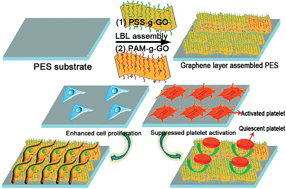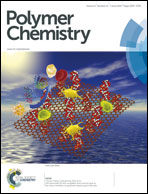Self-assembled 3D biocompatible and bioactive layer at the macro-interface via graphene-based supermolecules†
Abstract
Research on the interface self-assembly of functional layers is fuelled by diverse biomedical needs, like drug encapsulation and release, stem cell proliferation and differentiation, cell and tissue cultures, as well as artificial organs. In this study, a novel and biocompatible 3D composite layer is fabricated on a membrane substrate by the layer-by-layer (LBL) self-assembly of graphene-based 2D supermolecules. The graphene-based 2D supermolecules are prepared by grafting poly(styrenesulfonate) (PSS, polyanion) and poly(acrylamide) (PAM, polycation) onto graphene oxide (GO) through free radical polymerization. Then, the prepared graphene-based supermolecules are taken to construct a 3D porous thin film layer through a LBL process. Polyethersulfone (PES) membrane is chosen as the model substrate. The chemical composition, surface morphology, water contact angle, surface zeta-potential, blood compatibility and the cell compatibility are systematically investigated. The results indicate that the 2D graphene-based supermolecules are successfully assembled into a 3D porous thin film layer structure on the membrane surface. The assembled layer shows increased hydrophilicity, suppressed platelet adhesion, and a limited hemolysis ratio and complement activation compared to the pristine substrate. The cell morphology observation and cytotoxicity assays demonstrate that the 3D graphene layer shows superior performance both in endothelial and hepatocyte cells proliferation and morphology differentiation. In addition, the excellent anticoagulant bioactivities indicate that the 2D graphene-based supermolecules have heparin-mimicking biological activity. In general, the protocol of interface thin film layer self-assembly confers the modified substrates with integrated blood compatibility, cell proliferation and biological activity; which may forward the fabrication of multi-functional biomedical devices by using the 2D graphene-based supermolecules.


 Please wait while we load your content...
Please wait while we load your content...